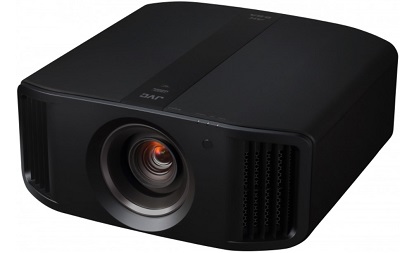Some projectors are known for their low input lags or plug-and-play design, and others for their immersive picture quality. JVC’s line of home theater projectors is at the top of the list when you want exceptional onscreen images.
The NX7 is no exception. It’s part of the JVC DLA line, and it doesn’t disappoint. However, considering its high price tag, it’s not a budget-friendly projector, you want to make sure it comes with everything you want.
In this JVC-NX7 review, we’ll take a closer look at the impressive 4K projector to see if it’s worth its price. (>>> Check current price on Amazon)
JVC NX7 Review of Specifications:
| JVC NX7 | |
|---|---|
 |
|
| Resolution | 4096x2160 |
| Contrast Ratio | 800,000:1 |
| Brightness (Lumens) | 1,900 ANSI |
| Throw Distance | 12.3' - 20.7' |
| Screen size | 60" - 201" |
| Internal Speakers | No |
| Price | ProjectorScreen.com |
You get a lot with the NX7 that includes stunning image quality. To see if it’s a good fit for your home, here’s what you get with the JVC 4K home theater projector.
Image Quality
You start with native 4K resolution for crisp, clear images, and the NX7 doesn’t stop there. Along with 8.3 million pixels per frame, the projector comes with plenty of technology to optimize images as they appear on the screen.
Along with HDR and HDR10 support, and Auto Tone Mapping, the projector comes with Clear Motion Drive and Motion Enhance technology. Fast-moving sports games and action movies will play smoothly frame-by-frame without any blurring or delays.
Blacks are deep and inky with an 800,000:1 dynamic contrast ratio. You can easily distinguish between blacks and greys, even in ambient lighting. The 1,900 lumens rating handles most low light, though you may have to darken the windows during the day. Bright sunlight can interfere with image quality.
Ease of Installation and Set-Up
Setting up the NX7 is a breeze, the only difficulty comes when you pick the projector up. It’s not the heaviest model in the projector line, but at 21 pounds it’s not one you want to move around.
You get all of the image-aligning technology you expect on a JVC projector. Vertical digital keystone correction, along with +/- 80% vertical and +/-34% horizontal lens shift and 2x motorized zoom ensure images are perfectly aligned with the screen.
Even if you’re still struggling with lens positions, don’t worry. The NX7 comes with 11 customizable modes for image settings and alignment.
Pros
- Dynamic contrast
- True 4K resolution
- Custom picture modes
- Accurate colors
- 3D support
Cons
- The remote is difficult to use if you’re not familiar with the design
- Blacks aren’t as deep and rich as with other projectors in the line
Connections
The NX7 has a standard connection panel. You can even go wireless for 3D content, though you need extra components like an RF emitter and shutter glasses. You can connect up to two devices to the dual HDMI 2.0 inputs. There are HDCP 2.2 ports, along with audio jacks.
You also get the standout outputs and connectors for device controls. You may not be able to connect all of your external devices without an A/V receiver, but image quality makes up for the lack of inputs.
Consumer Impressions

It’s hard to find a consumer review that doesn’t rave about the projector’s image quality. Colors are bright and vivid, while details are sharp and clear. The low latency speed appeals to casual gamers, and the customizable alignment settings make installation quick and easy. There are mentions about the lack of inputs, along with the projector’s sturdy construction. It’s a little bulky and hard to easily move around.
Conclusion
You can easily pay more for a 4K projector, but it’s hard to beat the image quality you get with the JVC NX7. Colors are vibrant and realistic across the spectrum. The projector is also easy to set up. You can also save your settings for the next time you want to watch a movie.
The NX7 is a smart buy if image clarity is your primary concern. It comes down to what you want from a home theater projector. (>>> Check on ProjectorScreen)
